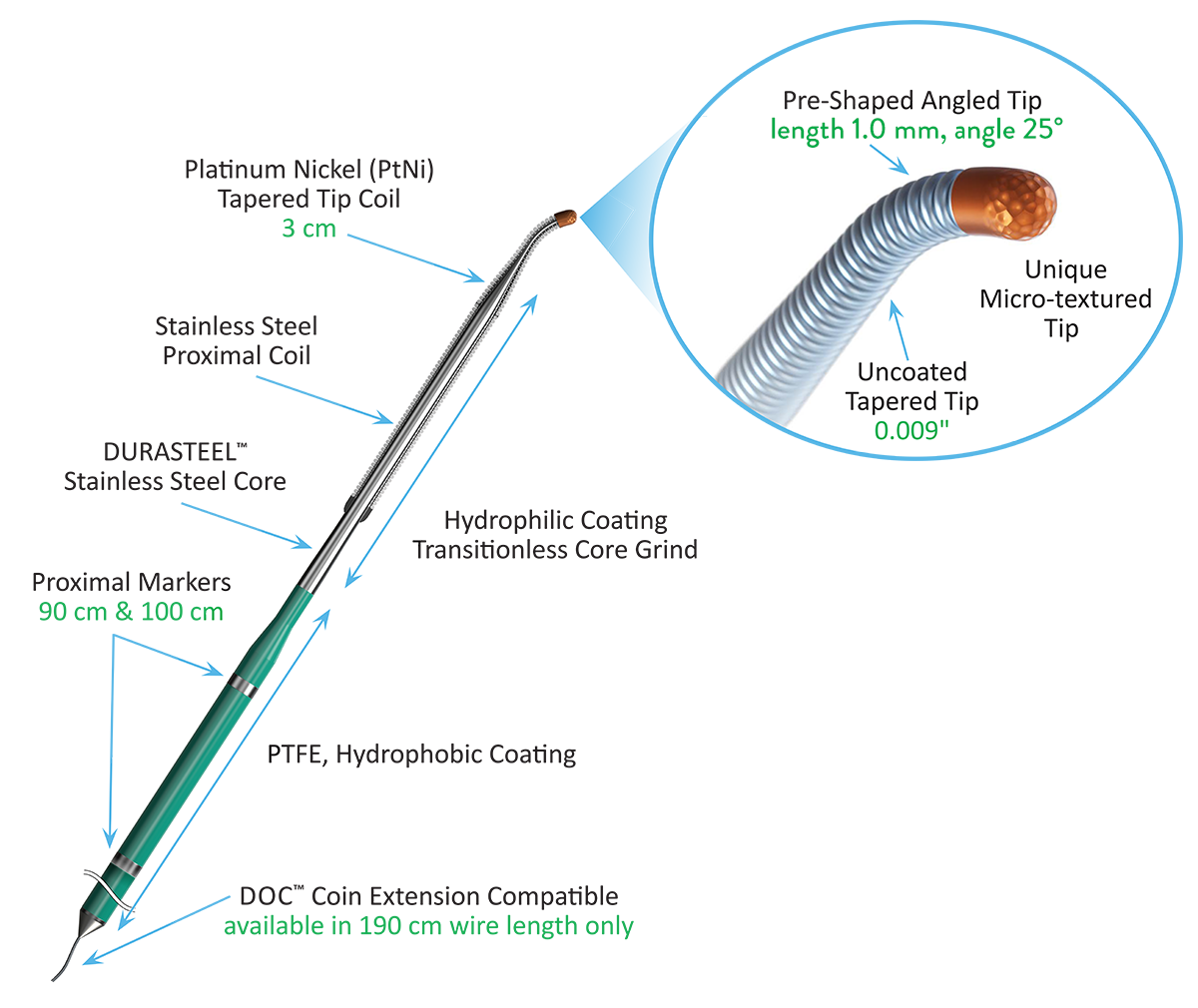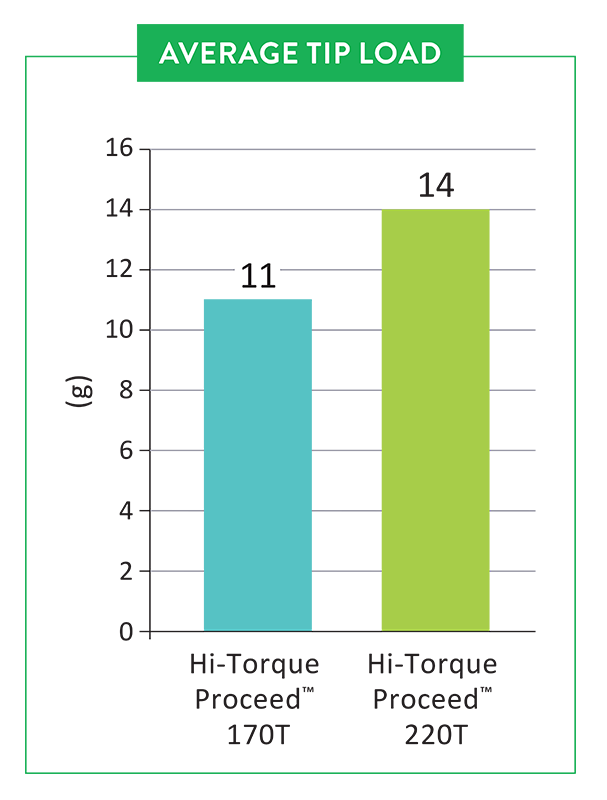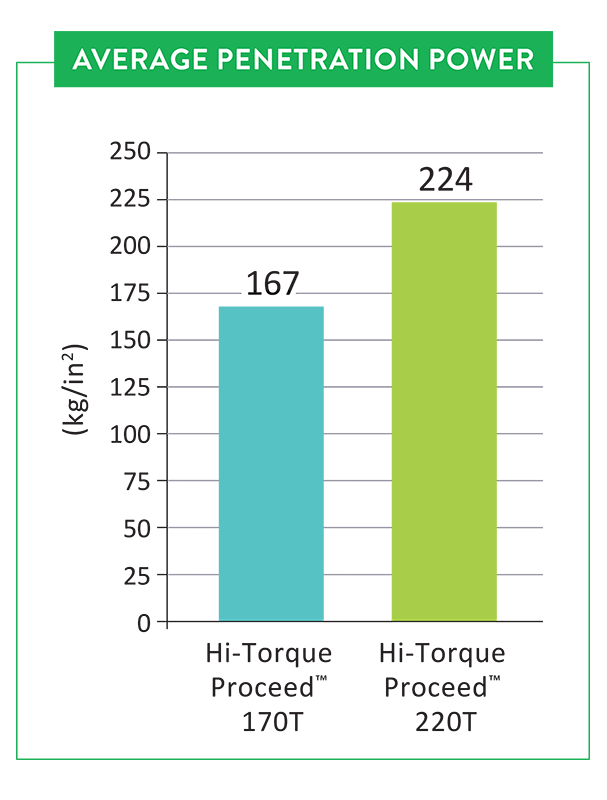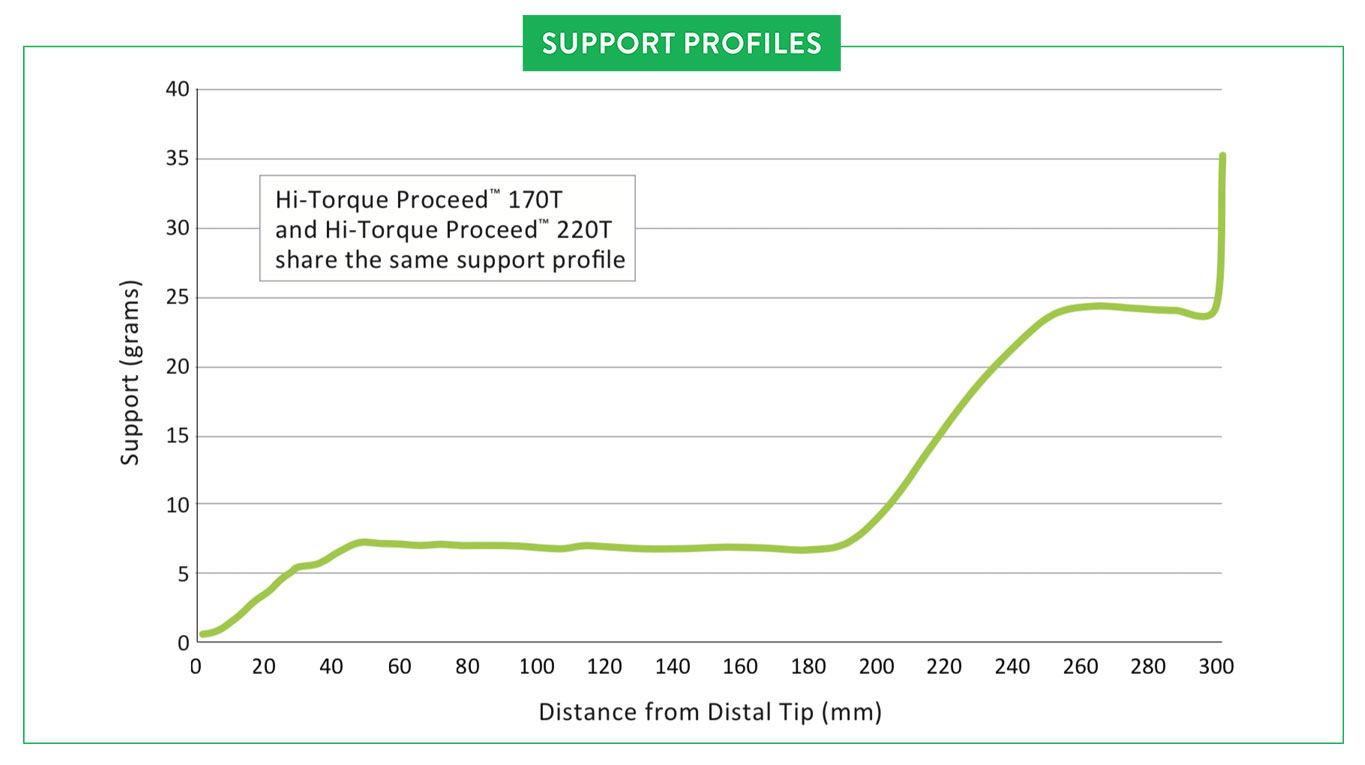Proceed in engaging and navigating through complex lesions.

Superb lesion engagement
Unique micro-textured tip
- Improve lesion engagement
- Reduce tip deflection off lesion
Uncoated tip
- Provides improved tactile feedback for tip positioning and navigation
Tapered tip
- For lesion penetration
Precise control and navigation
- 1 mm, 25° angled tip facilitates navigation through lesion and optimizes consistency of wire performance
Advancing options for crossing complex lesions
- Next-generation 014 specialty wire
- 2 levels of penetration power and tip loads provides options for various lesion types
Tip Load, Penetration Power, and Support Profiles



Ordering Information
| Product | Part Number | Diameter | Length | Tip Load | Tip Style | Units Per Package |
|---|---|---|---|---|---|---|
| Hi-Torque Proceed™, 170T, Angled | 1030901 | 0.014 in | 190 cm | 11 g | Core-to-Tip | 5 |
| Hi-Torque Proceed™, 170T, Angled | 1030902 | 0.014 in | 300 cm | 11 g | Core-to-Tip | 5 |
| Hi-Torque Proceed™, 220T, Angled | 1030903 | 0.014 in | 190 cm | 14 g | Core-to-Tip | 5 |
| Hi-Torque Proceed™, 220T, Angled | 1030904 | 0.014 in | 300 cm | 14 g | Core-to-Tip | 5 |
Reference
Data on file at Abbott
MAT-2101436 v2.0
Hi-Torque Proceed™
Guide Wire

Indications for Use
Intended to facilitate the delivery of catheter-based interventional devices during percutaneous transluminal angioplasty (PTA), in arteries such as the femoral, popliteal, and infrapopliteal arteries. This guide wire may be used with compatible stent devices during therapeutic procedures. The guide wire may be used to reach and cross a target lesion, provide a pathway within the vessel structure, facilitate the substitution of one diagnostic or interventional device for another, and to distinguish the vasculature.
Contraindications
Not intended for use in the cerebral vasculature.
Warnings
This device is not designed for use with atherectomy devices. The safety and effectiveness of the use of this Hi-Torque™ Guide Wire with atherectomy devices are unestablished.
The lifetime of this device is the labeled shelf life. This device is designed and intended for ONE-TIME USE ONLY. Do not resterilize and / or reuse. The safety and effectiveness of this device have not been established after being reprocessed for multiple uses.
This device has a hydrophilic coating at the distal end of the device for a length of 25.6 cm, and a silicone based hydrophobic coating at the proximal end for a length of 133 cm (on 190 cm wires) and 250 cm (on 300 cm wires), and a polytetrafluoroethylene (PTFE) hydrophobic coating at the proximal end for a length of 156.5 cm (on 190 cm wires) and 266.5 cm (on 300 cm wires).
Please refer to section PREPARATION FOR USE for further information on how to prepare and use this device to ensure it performs as intended. Failure to abide by the warnings in this labeling might result in damage to the device coating, which may necessitate intervention or result in serious adverse events.
Use extreme caution and careful judgement in patients for whom anticoagulation is not indicated.
If contrast agents are used, use extreme caution in patients who have had a severe reaction to contrast agents and who cannot be adequately premedicated.
The safety and effectiveness of this device have not been established, or is unknown, in vascular regions other than those specifically indicated.
This device contains stainless steel, platinum-nickel alloy, tin-silver alloy, gold-tin alloy, Microglide™ silicone coating, PTFE coating, polyvinylpyrrolidone (PVP) coating that may cause allergic or hypersensitivity reactions. Persons allergic to these may suffer an allergic reaction to this guide wire. Prior to its use on the patient, the patient should be counseled on the materials contained in the device, and a thorough history of allergies must be discussed.
Carefully observe the instructions under “Do Not” and “Do” below. Failure to do so may result in vessel trauma, guide wire damage, guide wire tip separation, or stent damage. If resistance is observed at any time, determine the cause under fluoroscopy and take remedial action as needed. Use the most suitable guide wire for the lesion being treated.
Do Not:
- Push, auger, withdraw, or torque a guide wire that meets resistance.
- Torque a guide wire if the tip becomes entrapped within the vasculature.
- Allow the guide wire tip to remain in a prolapsed condition.
- Deploy a stent such that it will entrap the wire between the vessel wall and the stent.
Do:
- Advance or withdraw the guide wire slowly.
- Use the radiopaque marker of the interventional device to confirm position.
- Examine the tip movement under fluoroscopy before manipulating, moving, or torquing the guide wire.
- Observe the wire under fluoroscopy for tip buckling, which is a sign of resistance.
- Maintain continuous flush while removing and reinserting the guide wire to prevent air from entering the catheter system. Perform exchanges slowly to prevent air entry and / or trauma.
- When reintroducing the guide wire, confirm that the interventional device tip is free within the vessel lumen and that the tip is parallel to the vessel wall.
- Use extreme caution when moving a guide wire through a non-endothelialized stent, or through stent struts, into a bifurcated vessel. Use of this technique involves additional patient risks, including the risk that the wire may become caught on the stent strut.
- Consider that if a secondary wire is placed in a bifurcation branch, this wire may need to be retracted prior to stent deployment, because there is additional risk that the secondary wire may become entrapped between the vessel wall and the stent.
For the Hi-Torque™ guide wire family only: The Hi-Torque family of guide wires have distal ends of varying stiffness. Operate these guide wires carefully so as to not injure the blood vessel, observing the information in these instructions. The higher torque performance, stiffer distal ends, and / or higher advancement force may present a higher risk of perforation or injury than a guide wire with a more pliable distal end. Therefore, use the guide wire with the least stiff distal end that will treat the lesion, and use extreme care to minimize the risk of perforation or other damage to blood vessels.
Precautions
Guide wires are delicate instruments and should be handled carefully. Prior to use and when possible during the procedure, inspect the guide wire carefully for bends, kinks, or other damage. Do not use damaged guide wires. Using a damaged guide wire may result in vessel damage and / or inaccurate torque response.
Confirm the compatibility of the guide wire diameter with the interventional device before actual use.
Please refer to the indication on the label and the Instructions for Use to confirm the appropriate vasculature that this guide wire may be used in. Failure to abide by the above recommendation may result in size mismatch of blood vessel and guide wire, which can result in vessel injury, such as, but not limited to, perforation, dissection, rupture, and avulsion.
Free movement of the guide wire within the interventional device is an important feature of a steerable guide wire system, because it gives the user valuable tactile information. Test the system for any resistance prior to use. Adjust or replace the hemostatic valve with an adjustable valve if it is found to inhibit guide wire movement. It is recommended that the user determine the source of resistance, exercise caution when removing the device and / or other components as a unit, and exchange the device for a new one to complete the procedure.
Never attach the torque device to the modified portion of the proximal end of the extendible guide wire; otherwise, guide wire damage may occur, preventing the ability to attach the DOC™ Guide Wire Extension.
Avoid abrasion of the hydrophilic coating. Do not withdraw or manipulate the hydrophilic-coated wire through a metal cannula or sharp-edged object. Manipulation, advancement, and / or withdrawal through a metal device may result in destruction and / or separation of the outer coating, which may cause coating material to remain in the vasculature. This in turn may lead to unintended adverse events requiring additional intervention.
After use, this product may be a potential biohazard. Handle and dispose of it in accordance with accepted medical practice and applicable local, state, and federal laws and regulations.
CAUTION: Federal law restricts this device to sale by or on the order of a licensed healthcare practitioner.
When wet, a hydrophilic coating increases the lubricity of the guide wire surface.
Do not soak the device for longer than 4 hours when the device is not in use. Avoid pre-soaking devices for longer than instructed, as this may impact the coating performance.
Percutaneous transluminal angioplasty (PTA) should only be performed at centers where emergency peripheral artery bypass surgery is available.
This guide wire family has distal ends of varying stiffness. Operate these guide wires carefully so as to not injure the blood vessels, observing the information in these instructions. The higher torque performance, stiffer distal ends, and / or higher advancement force may present a higher risk of perforation or injury than a guide wire with a more pliable distal end. Therefore, use the guide wire with the least stiff distal end that will treat the lesion, and use extreme care to minimize the risk of perforation or other damage to blood vessels.
The coating swells when exposed to aqueous media, but does not have any impact on device use.
The user and / or patient should report any serious incident that has occurred in relation to the Hi-Torque Proceed™ Guide Wire to the manufacturer and the competent authority of the European Member State in which the user and / or patient is established.
The integrity and performance of the device coating can be negatively impacted by preparation with incompatible media or solvents. Please take note of the following important recommendations:
- Avoid wiping the device with dry gauze as this may damage the device coating.
- Avoid excessive wiping of the coated device.
- Avoid using alcohol, antiseptic solutions, or other solvents (e.g., use of medications and rotoflush) to pre-treat the device because this may cause unpredictable changes in the coating which could negatively affect the safety and performance of the guide wire.
Attempting to alter the shape of devices by bending, twisting, or similar methods beyond instructed methods may compromise the coating integrity, and that damage to the coating may not always be noticeable to the naked eye.
Adverse Events
Potential adverse events associated with use of this device may include the following but are not limited to:
- Allergic reaction or hypersensitivity to latex, contrast agent, anesthesia, device materials, and drug reactions to anticoagulation, or antiplatelet drugs
- Vascular access complications which may require transfusion of vessel repair, including:
- Bleeding (ecchymosis, oozing, hematoma, hemorrhage, retroperitoneal hemorrhage)
- Arteriovenous fistula, pseudoaneurysm, aneurysm, dissection, perforation / rupture, and laceration
- Embolism (air, tissue, plaque, thrombotic material or device)
- Target artery complications which may require additional intervention, including:
- Total occlusion or abrupt closure
- Arteriovenous fistula, pseudoaneurysm, aneurysm, dissection, perforation / rupture
- Embolism (air, tissue, plaque, thrombotic material or device)
- Artery or stent thrombosis
- Stenosis or restenosis
- Vessel spasm
- Claudication
- Venous thromboembolism (including pulmonary embolism)
- Hypotension / hypertension
- Peripheral nerve injury, neuropathy
- Other ischemic conditions / infarction
- Tissue / organ ischemia
- Tissue necrosis
- Ulcer
- Acute limb ischemia
- Infection – local and systemic (including post-procedural)
- Abscess
- Sepsis / infection including bacteremia / cellulitis / septicemia
- Contrast-induced renal insufficiency or renal failure
MAT-2007522 v2.0
